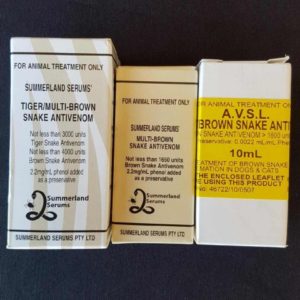The Dog Blog
Veterinary Antivenom
Posted May 1, 2017 in General
 We are not vets. However we work with and have trained several vets’ dogs and many of their customers’ dogs. It amazes me the devotion that many vets and vet nurses have to their work – some being available 24/7 especially for time critical emergencies like snakebite where snake antivenom may be required.
We are not vets. However we work with and have trained several vets’ dogs and many of their customers’ dogs. It amazes me the devotion that many vets and vet nurses have to their work – some being available 24/7 especially for time critical emergencies like snakebite where snake antivenom may be required.
Antivenom is produced by collecting venom from the relevant animal – say a dugite – and introducing small amounts of it into a domestic animal, usually a horse. The horse gradually becomes immunized to that venom type. The antibodies that form are carefully removed from the horse’s blood and purified. This is then called antivenom or antivenine. This is given intravenously and will target and neutralize the venom in the affected patient.
Example:Brown snakes
Eastern Brown (Pseudonaja textilis), Gwardar or Western Brown (Pseudonaja nuchalis) and Dugite (Pseudonaja affinis). These 3 species alone account for over 70% of bites in Australia.
Some antivenoms have a fridge shelf life of 30 months. They are best administered by intravenous (IV) route, with adrenaline, antihistamine and steroids available to treat any reactions to the antivenom. Clinical judgment is made as to how much antivenom is required. Many factors are involved including timing of bite, number of strikes, amount of venom injected.
Arrive alive = stay alive – prompt delivery of pet to vet saves lives.
Keep emergency vet number on phone or handy.